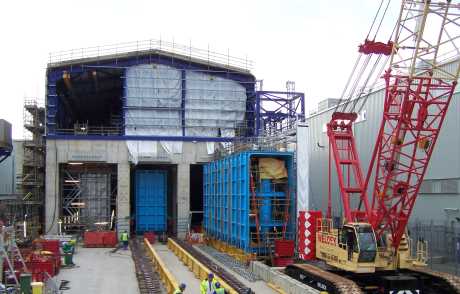A new £240 million ($402 million) facility to handle radioactive sludge at the UK's Sellafield site has been handed over for final trials after the completion of a six-year construction project.
 |
| SPP1's three buffer storage vessels were welded together on site and slid into the reinforced concrete building (Image: Sellafield Ltd) |
The Sludge Packaging Plant (SPP1) comprises three 240-tonne stainless steel buffer storage vessels into which radioactive sludge from the adjacent First Generation Magnox Storage Pond (FGMSP) will be transferred via a pipebridge. Made of 25mm stainless steel, the vessels were shipped in sections which were welded together on site and slid into the reinforced concrete building. They are the largest stainless steel fabrication to be installed on the site since the 1980s.
SPP1 has been built to deal with an estimated 1500 cubic metres of sludge that accumulated in the FGMSP over its 26-year operating life. In that time, the pond handled an estimated 2.5 million used fuel rods from the Magnox power plants in the UK, Italy and Japan prior to reprocessing. Built in the 1950s, the pond had no roof and was open to the elements. Sludge accumulated in the bottom of the pond in the same way that it would in a garden pond or any similar body of water - the only difference being that the sludge in the FGMSP became radioactive thanks to the irradiated fuel rods stored in the water above it.
The first concrete for SPP1 was poured in 2008. Final commissioning tests are to be carried out using sludge retrieved from the bottom of the pond and piped across into the new facility, with the unit expected to receive its first sludge by the end of the year. Installation of the 50-tonne, 31-metre long single-span pipebridge linking FGMSP and SPP1 presented one of the project's biggest challenges, requiring one of the most technically challenging crane lifts ever performed on the Sellafield site.
Head of FGMSP Martin Leafe explained that transferring the sludge from the bottom of the 7-metre deep pond is a difficult task. Recent trials using a mini submarine and a powerful jet pump have proved that the team has the technology to lift the sludge, which is up to one metre deep in places, from the pond floor. Pulse jet mixers inside the buffer storage vessels will prevent the sludge from settling out again, keeping it mobilised ready to be processed into a form suitable for final disposal. "We can now make significant progress in decommissioning part of the UK's historic nuclear legacy, that up until now we didn’t have the means to deal with," said Leafe.
Project manager Karl Mason said that finishing off the project had been a challenge, and praised main contractors Doosan Babcock and Balfour Beatty. "To take the project from a starting point where we didn’t even have a design, to a position that you are pressing the button and making it work and handing the plant over for active commissioning preparations to then seeing the sludge being transferred into the facility later in the year will be very satisfying," he said.
Researched and written
by World Nuclear News





_18570.jpg)
_16159.jpg)
_49205.jpg)





